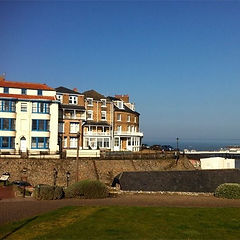
About Cromer
With its pier and its two museums, wide open beaches, spectacular cliffs, its famous pier show, its cinema with three screens, there's lots to enjoy in Cromer. There are many glorious walks in the neighbourhood, the town's Folk Festival and Carnival, , Lifeboat Day and Firework displays and many other places to visit in north Norfolk. Please see This Is Cromer web site for more details of local events and attractions,
The streets of Cromer today are little removed from how they looked in the Victorian era. Most of the great landmarks, many of which were created by the well-to-do Victorian "summer timers", still stand as familiar to the holiday makers of today as they were to their counterparts a hundred years ago.
Cromer does however have a much more ancient history than that, the magnificent church is a medieval legacy, a relic from the days when Cromer was still known as Shipden - a modest settlement of fishermen and merchants.
A small, almost impoverished town, Cromer was "discovered" in the 18th Century by well to do travellers as a watering place. Cromer began to grow, slowly at first due to its remoteness, but upon the arrival of the railway in 1877, linking Cromer with London and later the Midlands, development gathered pace. The Victorian travel writer Clement Scott coined the name "Poppyland" for the area, wrote about it in the national papers, and the people came, both to visit and to live. Land was released from Cromer Hall and estate developers began building hotels and residential areas.
By the 1890s Cromer was fashionable and booming. Many fine residences were built and the Urban District Council saw that the infrastructure - drainage, roads, schools, electricity and so on - was the best. In 1900 a new pier were erected and the promenade, first built sixty-five years before, was lengthened and enhanced. The suburban development of the 20th century, particularly of the post-war period has seen the town expand in every direction.
The Town's reputation for crab fishing is undiminished. You can still watch the crab boats arrive every morning with their catch. There are several small fish shops in town where you can buy one of the day's catch and virtually every eating place will have a crab dish on the menu.
For over two hundred years the town's lifeboats have helped those in trouble off the open north-east Norfolk coast. Hauling up the sails and pulling on the oars is not the way it's done now - a brand new high speed lifeboat sits in its pier head boathouse, ready for immediate action. On the east promenade the RNLI Henry Blogg Museum tells the story of its most famous lifeboatman and his colleagues over those two hundred year.
As well as one of Norfolk's most attractive seaside resorts, Cromer is also an important residential, administrative and service centre for the growing population of North Norfolk - yet it still retains the air of Victorian and Edwardian charm at its heart. A recent regeneration programme has enhanced this charm whilst introducing new facilities in the town and on the seafront. We hope you'll come and explore all this for yourself!

Richard III
Plaque commemorating the arrival in Cromer of Edward IV and Richard Duke of Gloucester in March 1471; the Gangway, Cromer.

Henry Blog
Coxswain Henry Blogg (1876-1954) was the RNLI's most decorated lifeboatman. During his 53 years of service Blogg was awarded three Gold and four Silver RNLI medals for gallantry, as well as the George Cross and British Empire Medal.
With the assistance of his dedicated crew, he launched some 387 times and helped to save 873 lives around the Cromer coast.

